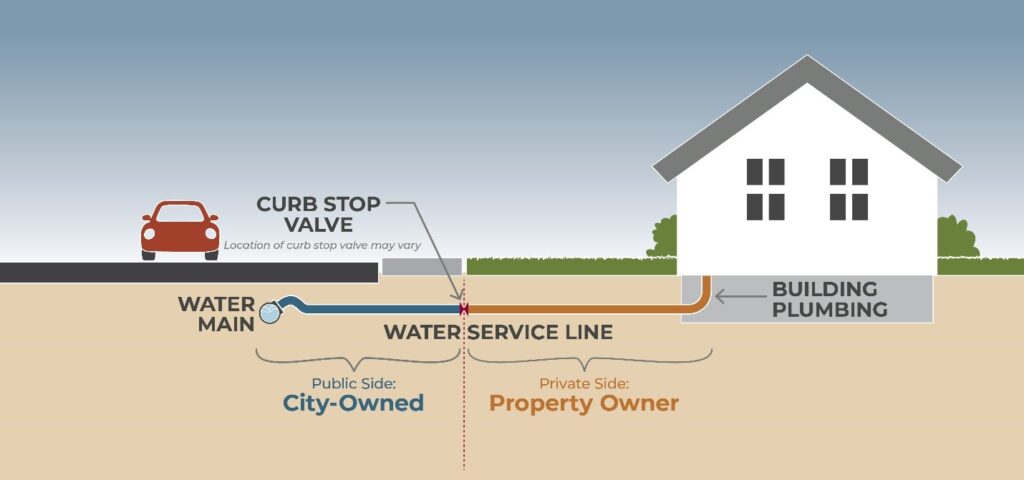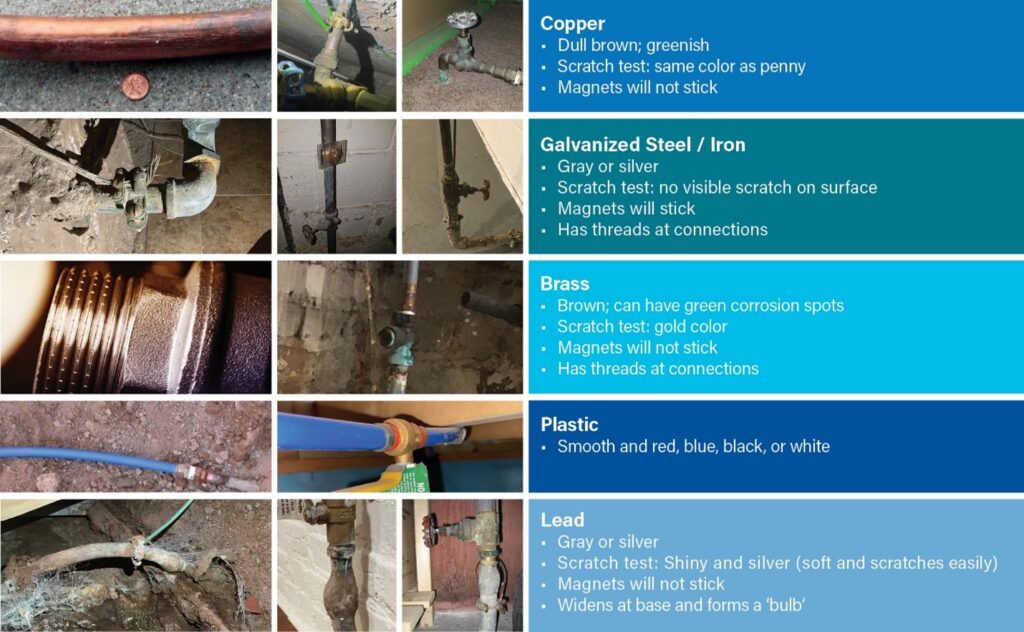The City of Rome is committed to providing clean and safe drinking water to our customers. Lead in drinking water can be harmful to human health. Your drinking water does not have lead in it when it leaves our Water Filtration Plant. But, lead service lines and lead in older plumbing fixtures can cause lead to enter your drinking water.
While the safety of our water has not changed, the U.S. Environmental Protection Agency (EPA) did change its Lead and Copper Rule in 2021. The revised rule requires us to take action to ensure the City of Rome’s drinking water is lead free. We need you to report your service line material to help complete our water service line inventory. Read on to learn more!
Water Service Line Inventory
The City of Rome is doing an inventory of all water service lines to rule out lead pipes from the street to the house to comply with the revised Lead and Copper Rule. A water service line is the pipe that brings water from the water main in the street into your property. Our inventory will include the part of the service line owned by the City of Rome (between the water main and the property line) and the part owned by the property owner (between the property line and the plumbing inside the building).

If your home was built in or after 1989, you DO NOT have a lead water service line.
If your home was built before 1989, you may have a lead service line.
We need your help to identify your water service line material.
Follow the steps below to check your water service line material.
Step 1: Get a strong magnet and a key or coin.
Step 2: Find out where your water service line enters your home. There will likely be a valve in a basement, crawl space, or utility closet where the pipe comes into the house.
Step 3: Scratch the pipe coming from the street with the key or coin, then hold the magnet and see if it sticks. Compare your results to the options below. Galvanized steel and lead look similar and the magnet test is the easiest way to tell the difference.

Step 4: Take a photo at the location where the pipe comes through the exterior wall.
Step 5: Register your account on the LeadCAST platform https://trinnex.cloud/leadcast/publicMap?tenantName=RomeNY to upload the photos and results. To register, follow these steps:
- Using the map below, input your physical address using the Search bar at the top right.
- Click on the circle to open the sidebar, which provides an overview of the material from the public side (City-owned) and the private side (property owner). Scroll to the button that says Report your Service Line.
- You will be taken to another page with a registration box. Click Register here for Online Access on the top green box.
- Input your information to register your account on LeadCAST and upload the photos and details of your water service line material.
- When asked, enter the Account ID (a letter and 5 numbers or no letter and 7 numbers) of your City water utility account number into the required field on the LeadCAST registration page. The account number can be found on paper and emailed account billing notices.
If you are having issues entering your information on LeadCAST, please email leadfreerome@romecitygov.com or call 315-339-7621.
What You Can Do
Lead Health Effects
Too much lead in your body can cause serious health risks. The greatest risk is to young children (especially under the age of six) and pregnant and or/breastfeeding women. Ingesting lead can slow a child’s mental and physical development, creating new learning and behavioral problems. In adults, lead can lead to increased risks of heart disease, high blood pressure, kidney, or nervous system problems.
How to Protect Yourself
While the City develops the inventory of service lines and next steps for addressing any lead pipes that are found, you can take the following steps to reduce lead in your drinking water:
- Run cold water before using. The longer the water stays in the plumbing, the more lead it may have. If the water in the faucet has been sitting for more than 6 hours, run water for 3 to 5 minutes before using it. Showering and flushing the toilet also help clear out your water line.
- Replace your home’s internal plumbing that may have lead. Potential lead sources include lead pipes, lead-based solder, and brass fixtures and valves (including faucets).
- Use cold water for cooking, drinking, and making baby formula. Lead dissolves into hot water more easily than cold water. If you need hot water, draw cold water and then heat it. It is safe to shower, wash dishes, and do laundry with hot water from the tap. Lead does not affect humans through the skin. Boiling water does NOT reduce lead.
- Remove and clean faucet strainers. Every 3 months, remove and clean strainers at the tip of faucets to remove build up.
- Remove the faucet strainers from all taps.
- Rinse the faucet strainers.
- Run the water without strainers for 3 to 5 minutes.
- Replace faucet strainers.
- Test your water for lead. Since you cannot see, taste, or smell lead in drinking water, testing it is the only way to know if it is present. You can use a New York State Department of Health (NYSDOH) certified laboratory to test your drinking water: https://tinyurl.com/NYStateLabs
- Test your child’s blood for lead. Your local doctor or pediatrician can perform a blood test for lead and provide you with information about the health effects of lead. To learn more, including where you can have your child’s blood tested, visit the New York Department of Public Health Childhood Lead Poisoning Prevention page or call the Oneida County Health Department Lead Program at 315-798-5064.
- Use filters. Use a pitcher filter approved to reduce lead (NSF 53-certified). Visit https://tinyurl.com/mr2fmdut to learn more about water filters.
- Replace your service line. In the unlikely event that you have a lead water service line, the City of Rome will work with you to create a replacement plan and expedite the permitting process. Replacement is voluntary; no one will be forced to replace their line.
EPA Lead and Copper Rule
EPA released the Lead and Copper Rule in 1991 to protect people from lead in drinking water. The U.S. EPA released Lead and Copper Rule Revisions on October 16, 2021, which aim to better protect children and communities at risk for lead exposure. Water utilities must comply with the revised rule by October 16, 2024. This includes the development of a materials inventory providing the material on both the public and private sides of the service line.
The EPA released draft improvements to the revisions in late 2023, which includes the requirement to replace all lead service lines within 10 years from when the Rule takes effect. However, the improvements are not final and in regulation yet. We expect them to be final in late 2024.
Frequently Asked Questions
- What is a water service line?
- A water service line is a small, buried pipe that brings water from water mains in the streets into homes and other buildings.
- What are the health effects of lead?
- Exposure to lead in drinking water can cause serious health effects in all age groups. Infants and children can have decreases in IQ and attention span. Lead exposure can lead to new learning and behavior problems or exacerbate existing learning and behavior problems. The children of women who are exposed to lead before or during pregnancy can have increased risk of these adverse health effects. Adults can have increased risks of heart disease, high blood pressure, kidney or nervous system problems.
- Is there a safe level of lead exposure?
- No, there is no safe level of lead exposure. Any amount of lead exposure has risk.
- What steps can I take to protect myself if I think I have lead in my water?
- Run cold water before using. The longer the water stays in the plumbing, the more lead it may have. If the water in the faucet has been sitting for more than 6 hours, run water for 3 to 5 minutes before using it. Showering and flushing the toilet also help clear out your water line.
- Replace your home’s internal plumbing that may have lead. Potential lead sources include lead pipes, lead-based solder, and brass fixtures and valves (including faucets).
- Use cold water for cooking, drinking, and making baby formula. Lead dissolves into hot water more easily than cold water. If you need hot water, draw cold water and then heat it. It is safe to shower, wash dishes, and do laundry with hot water from the tap. Lead does not affect humans through the skin. Boiling water does NOT reduce lead.
- Remove and clean faucet strainers. Every 3 months, remove and clean strainers at the tip of faucets to remove build up.
- Remove the faucet strainers from all taps.
- Rinse the faucet strainers.
- Run the water without strainers for 3 to 5 minutes.
- Replace faucet strainers.
- Test your water for lead. Since you cannot see, taste, or smell lead in drinking water, testing it is the only way to know if it is present. You can use a New York State Department of Health (NYSDOH) certified laboratory to test your drinking water: https://tinyurl.com/NYStateLabs
- Test your child’s blood for lead. Your local doctor or pediatrician can perform a blood test for lead and provide you with information about the health effects of lead. To learn more, including where you can have your child’s blood tested, visit the New York Department of Public Health Childhood Lead Poisoning Prevention page
- Use filters. Use a pitcher filter approved to reduce lead (NSF 53-certified). Visit https://tinyurl.com/mr2fmdut to learn more about water filters.
- Replace your service line. In the unlikely event that you have a lead water service line, the City of Rome will work with you to create a replacement plan and expedite the permitting process. Replacement is voluntary; no one will be forced to replace their line.
- Who is responsible for the water service line on my property?
- The City of Rome is responsible for the service line from the water main in the street to the property line. The property owner is responsible for the service line from the property line to the plumbing inside your home. See example.
- Why might the water service line or plumbing fixtures at my home have lead?
- Lead used to be common in water service lines and home plumbing. Older homes and buildings, especially those built before 1989, may still have service lines and internal plumbing and fixtures with lead. The U.S. EPA allowed “lead free” plumbing fixtures to have up to 8% lead until 2014. A licensed plumber can help figure out if you have lead in your indoor plumbing.
